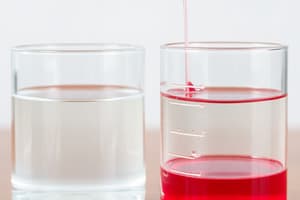Podcast
Questions and Answers
What is the primary factor that determines the colligative properties of a solution?
What is the primary factor that determines the colligative properties of a solution?
- Number of solute particles relative to solvent particles (correct)
- Concentration of the solvent
- Temperature of the solution
- Type of solute particles
Which of the following is an example of a colligative property?
Which of the following is an example of a colligative property?
- Viscosity
- Osmotic pressure (correct)
- Color
- Conductivity
What is the primary function of a semipermeable membrane in osmosis?
What is the primary function of a semipermeable membrane in osmosis?
- To permit the passage of only solvent molecules (correct)
- To block the passage of both solvent and solute molecules
- To permit the passage of solute molecules
- To permit the passage of both solvent and solute molecules
What is the characteristic of an isotonic solution?
What is the characteristic of an isotonic solution?
What is the purpose of using an isotonic solution in medical applications?
What is the purpose of using an isotonic solution in medical applications?
What is the concentration of an isotonic solution of sodium chloride?
What is the concentration of an isotonic solution of sodium chloride?
What is the reason a 2.0% solution of boric acid causes rapid hemolysis?
What is the reason a 2.0% solution of boric acid causes rapid hemolysis?
Why is a 2.0% boric acid solution isotonic with blood cells?
Why is a 2.0% boric acid solution isotonic with blood cells?
What is the function of the mucous lining of the eye in relation to boric acid in solution?
What is the function of the mucous lining of the eye in relation to boric acid in solution?
What is the freezing point of both human blood and lacrimal fluid?
What is the freezing point of both human blood and lacrimal fluid?
What is the principle behind the hemolytic method of measuring tonicity?
What is the principle behind the hemolytic method of measuring tonicity?
What is the concentration of NaCl solution that is isotonic with both blood and lacrimal fluid?
What is the concentration of NaCl solution that is isotonic with both blood and lacrimal fluid?
What happens to red blood cells when they are suspended in a 2.0% NaCl solution?
What happens to red blood cells when they are suspended in a 2.0% NaCl solution?
What is the term for the phenomenon where red blood cells swell and finally burst due to an influx of water?
What is the term for the phenomenon where red blood cells swell and finally burst due to an influx of water?
What is the osmotic pressure of body fluids, such as blood and lachrymal fluids, equivalent to?
What is the osmotic pressure of body fluids, such as blood and lachrymal fluids, equivalent to?
What is the term for a solution with an osmotic pressure higher than that of a 0.9% NaCl solution?
What is the term for a solution with an osmotic pressure higher than that of a 0.9% NaCl solution?
What is the term for a solution with an osmotic pressure equal to that of a 0.9% NaCl solution?
What is the term for a solution with an osmotic pressure equal to that of a 0.9% NaCl solution?
What is the difference between iso-osmotic and isotonic?
What is the difference between iso-osmotic and isotonic?
Flashcards are hidden until you start studying
Study Notes
Colligative Properties
- Characteristic properties of a solution that depend on the number of solute particles to the solvent particles.
- These properties include: osmotic pressure, boiling point elevation, vapor-pressure lowering, and freezing point depression.
Osmosis
- The process through which the solvent passes through a semipermeable membrane to dilute a solution having a higher osmotic pressure.
- Semipermeable membrane permits the passage of only the solvent molecules, not the solute molecules.
Isotonic Solutions
- Solutions that contain the same concentration of water and solutes as the cell cytoplasm.
- The isotonic solution has the same osmotic pressure as the physiologic fluid and does not cause swelling or contraction of the tissues with which it comes in contact.
- Example: 0.9% NaCl solution is isotonic with blood and lachrymal fluids.
Physiologic Fluid
- Body fluids, such as blood and lachrymal fluids, with an osmotic pressure corresponding to that of 0.9% NaCl solution.
Isotonicity and Hemolysis
- A 2.0% solution of boric acid is iso-osmotic with blood but causes rapid hemolysis because the molecules of boric acid pass freely through the erythrocyte membrane.
- A solution is isotonic only when the blood cells are impermeable to it.
Measurement of Tonicity
- The hemolytic method: based on the liberation of oxyhemoglobin in direct proportion to the number of cells hemolyzed.
- Using the colligative properties: based on a measurement of the slight temperature differences arising from differences in the vapor pressure.
Hypertonic and Hypotonic Solutions
- Hypertonic solution: a solution with an osmotic pressure higher than 0.9% NaCl, causing the cells to shrink and become wrinkled.
- Hypotonic solution: a solution with an osmotic pressure lower than 0.9% NaCl, causing the cells to swell and finally burst or rupture.
- Example: 2.0% NaCl solution is hypertonic, and 0.2% NaCl solution is hypotonic.
Distinction between Iso-osmotic and Isotonic
- The terms iso-osmotic and isotonic are not equivalent.
- A solution can be iso-osmotic but not isotonic, causing hemolysis of red blood cells.
Studying That Suits You
Use AI to generate personalized quizzes and flashcards to suit your learning preferences.




